How To Measure Yourself For A Custom Tailored Suit / Tuxedo
Made To Measure
So you’re ready to get your very own custom made suit or tuxedo. Our made to measure garments are made on a per order basis. This means that your garment’s fabric is not measured and cut until after you’ve sent in your measurements. For this very reason our suits and tuxedos fit so much better than anything you could ever find off-the-rack! Your garment is specifically made to your body measurements and is crafted for you alone. If you’re ready to begin grab your nearest tape measure, download our measurement form and grab a friend.
What You'll Need:
- A Friend
- Tailor's Tape Measure (centimeters)
- And ~ 10 Minutes
It is recommended to use a desktop computer.
*to save the PDF right click the link and click “save link as” then select your destination.
Body Measuring Guide
This is a judgement free zone, answer this honestly and you'll love how your suit fits
Most of these measurements can be completed by yourself. However, having the assistance of a friend would really make this whole process run a lot faster, and it generally produces better results in our experience. You should wear good fitting clothes that are not baggy. And please make sure that all of your pockets are empty before starting.
When you are taking measurements the tape measure should be held flat against the body. The tape measure should be held snug enough that it does not droop, but never too tight that you reel restricted by it.
Please make sure that you perform all of your measurements in CENTIMETERS. The measurement form that you will fill out is in CENTIMETERS. The only portion that is not in CENTIMETERS is your height measurement at the top of the form. And DO NOT ADD any wiggle room to any of your measurements. Your garment will be made according to your measurements, adjustments will be made according to the picture preferences and suit style you select (i.e. slim, classic, loose).
With the PDF measurement form open you can begin. After filling out your name, age, height and weight you can move on to body shape.
Body Shape Pictures
Your Stance / Posture
Select the picture that best represents your body stance / posture.
Normal
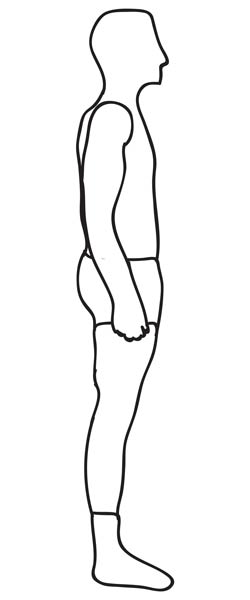
Forward Leaning
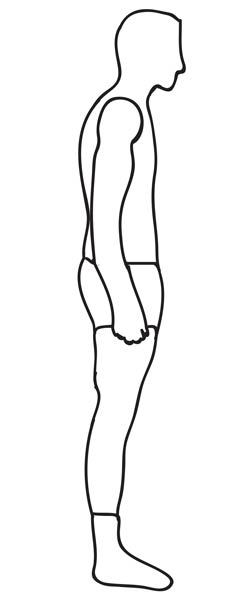
Erect
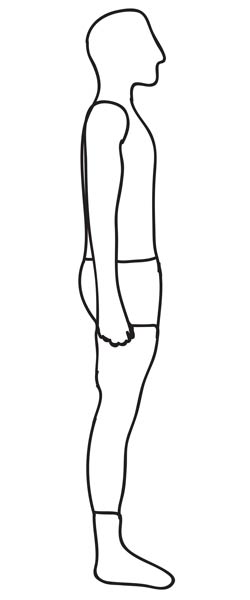
Your Shoulder Slope
Select the picture that best represents your shoulder slope.
Normal

Steep
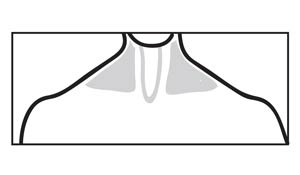
Flat
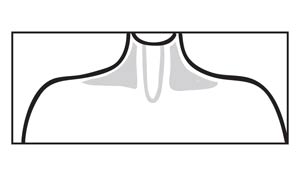
Your Chest Shape
Select the picture that best represents your chest shape.
Thin
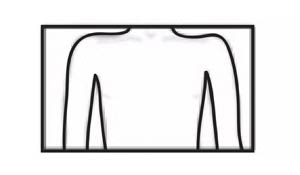
Fit

Normal
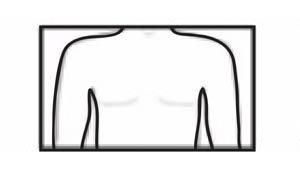
Muscular
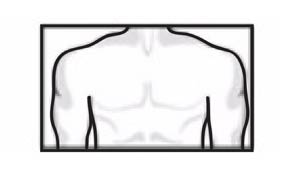
Large
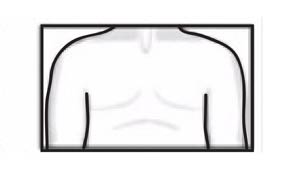
Your Stomach Shape
Select the picture that best represents your stomach shape.
Thin

Normal
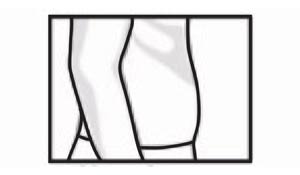
Medium
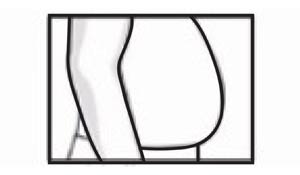
Large

Your Seat / Butt Shape
Select the picture that best represents your seat / butt shape.
Thin

Normal
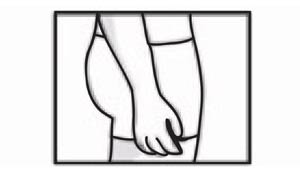
Curved
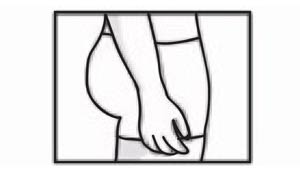
Large

Measurement Videos
For the next section you should grab a friend and a tailors tape measure. Remain relaxed throughout this process. DO NOT flex muscles creating larger measurements to look cool, your suit will be made to those larger numbers and look horrible. DO NOT suck in your stomach to appear thin, this will ruin your suit’s fit making it too tight. DO NOT add wiggle room or guess on your measurements.
ALL MEASUREMENTS MUST BE IN CENTIMETERS
#1 - Neck Measurement
Locate your Adam’s apple. It is important to measure just beneath your Adam’s apple. Now, measure around your neck. It should be comfortable to breath while resting your index finger underneath the measuring tape.
Record your measurement (centimeters) using the PDF form.
Note: If you get a half centimeter or greater measurement, then it is recommended to round up.
#2 - Full Chest Measurement
Locate your nipples. This measurement needs to be taken at the fullest or widest parts of your chest, generally where your nipples are located. Measure around your body over the nipples and underneath your arms while they’re at your sides. Keep the tape measure level and with one finger underneath the measuring tape record your measurement (centimeters). Add this # to the measuring form.
Note: If you get a half centimeter or greater measurement, then it is recommended to round up.
#3 - Full Shoulder Measurement
Locate the point where the vertical and horizontal planes of your arm and shoulder meet. If you are wearing a well fitted shirt the seams on your shirt can depict these points fairly well, but don’t rely on this. Find the points using your hands. Once you’ve found these points you can measure. The tape measure should follow the natural curve across the top of your shoulder. Measure between the two points where the shoulder and arm planes meet. We recommend triple checking this measurement to ensure accuracy.
Note: If you get a half centimeter or greater measurement, then it is recommended to round up.
#4 - Sleeve Measurement
Remember the point where your arm and shoulder planes met? Find this point and measure to the pinch of your thumb keeping the tape measure straight. The person being measured should stand straight with their arms at their side. The pinch of your thumb is the point where the base of your thumb and the base of your index finger meet.
Following this guide will produce a suit jacket with sleeves that rest at the pinch of your thumb when standing straight up. If you prefer slightly shorter sleeves then measure to the distance you prefer your sleeves when you are standing. We recommend not going shorter by more than 3cm from the pinch of your thumb or risk extremely short sleeves.
Remember, longer sleeves can be tailored shorter but shorter sleeves cannot be made longer.
Note: If you get a half centimeter or greater measurement, then it is recommended to round up.
#5 - Bicep Measurement
Roll up your sleeves so that your bicep is clearly visible. Measure around the fullest / widest part of your bicep while your arms rest at your side. Record the measurement with one finger underneath the measuring tape. Double check this measurement, both arms should be about the same +/- 1 or 2 cm — Go with the larger measurement.
DO NOT FLEX your biceps, this will result in your measurement being excessively large and having baggy sleeves on your jacket.
Note: If you get a half centimeter or greater measurement, then it is recommended to round up.
#6 - Wrist Measurement
If you’re wearing a watch or bracelet please remove them before taking this measurement. Now, measure around the fullest / widest part of your wrist with one finger underneath the measuring tape. Record your measurement (centimeters).
Note: If you get a half centimeter or greater measurement, then it is recommended to round up.
#7 - Stomach Measurement
Locate your belly button. Measure around the fullest / widest part of your stomach which is usually near your belly button or just under the bottom of your ribs. The tape should not be tight or loose. It should feel comfortable to breath. Record your measurement when the tape measure is level around your body with one finger underneath the measuring tape.
DO NOT suck in your stomach, the only person that this affects is you. Embellishing your stomach measurement will produce a tight fitting jacket that you will not appreciate. Thank you.
Note: If you get a half centimeter or greater measurement, then it is recommended to round up.
#8 - Seat / Butt Measurement
Lift your shirt up and out of the way and make sure that your pockets are empty. No phones, wallets or keys should be in your pockets as these can mess up the measurement. Now, measure around the fullest / widest part of your butt. Keep the tape measure level around your butt and record your measurement with one finger underneath the measuring tape.
Note: If you get a half centimeter or greater measurement, then it is recommended to round up.
#9 - Jacket Length Measurement
Your jacket length measurement begins where the base of your neck meets the top of your shoulder. Find this intersecting point where the vertical plane of your neck meets the horizontal plane at the top of your shoulder. Measure from this point straight down the front of your torso and stop when you are level with the knuckle on your thumb. Record your measurement (centimeters).
Note: If you get a half centimeter or greater measurement, then it is recommended to round up.
#10 - Front Chest Measurement
Locate your nipples and armpit crease. Stand straight and relaxed with your arms at your side. Do not suck in or puff out your chest. Measure from the crease of your armpits over the widest point of your chest (usually at your nipples) to the other armpit crease. Do not measure underneath your arms. Record your measurement (centimeters).
Note: If you get a half centimeter or greater measurement, then it is recommended to round up.
#11 - Back Width Measurement
Stand straight and relaxed with your arms at your sides. Locate your armpit creases and the widest part of your back. Measure across the fullest / widest parts of your back between armpit creases. You start and end at the armpit crease, but do not measure underneath the arms. Record your measurement (centimeters).
Note: If you get a half centimeter or greater measurement, then it is recommended to round up.
#12 - Half Shoulder Measurement
Pop your collar so that it is out of the way. Now, locate the point where the base of your neck meets the top of your shoulder. You will measure from this point straight across the top of your shoulder to the point where your shoulder and arm meet. This point is where you stated your sleeve and full shoulder measurements. Again, the point is where the horizontal plane of the shoulder meets the vertical plane of the arm. Both half shoulder lengths should be about the same, double check this measurement. Record your measurement (centimeters).
Note: If you get a half centimeter or greater measurement, then it is recommended to round up.
#13 - Half Back Length Measurement
Adjust your pants to your desired height so that your pants waistband is where you prefer it to be. Measure from the base of the back of the neck to the top of the waistband on your pants. The base of your neck is where your neck and shoulder meets. Record your measurement (centimeters).
Note: If you get a half centimeter or greater measurement, then it is recommended to round up.
#14 - Pant Waist Measurement
Measure around your waist at the level where you would normally where your pants with a belt. Make sure you keep the tape measure level and snug around your waist. Take the measurement with one finger underneath the tape. DO NOT suck in your stomach to get a smaller measurement, doing so will result in your pants being very tight. Record your measurement (centimeters).
Do not be alarmed if your measurement is larger than you expected. Off the rack / store bought pants are normally labeled as being smaller than what they really are.
Note: If you get a half centimeter or greater measurement, then it is recommended to round up.
#15 - Pant Length Measurement
It is very important that you take this measurement with your shoes off. Stand straight up with your feet flat on the ground. Now make sure your pants waistband is at the height your normally wear your pants at. Measure from the top of your pants waistband to the floor along the outside of your leg. Make sure the tape measure is tight and that you’re standing straight. Double check this measurement for accuracy! Record your measurement (centimeters).
Note: If you get a half centimeter or greater measurement, then it is recommended to round up.
#16 - Crotch Measurement
Lift your shirt or tuck it in so that you can clearly see your waistband. Make sure your pants are at the height you normally wear your pants at. Now, measure from the top of the front of your waistband through your legs to the top of the waistband on the back of your pants. Adjust the tape measure so that it feels comfortable between your legs. DO NOT make it too tight or too lose. If you measure too tightly then you will leave no room in your pants for your junk, and if you measure too loosely you will have so much room for your junk you can have a party down there (this would look bad, think of baggy crotch area). Record your measurement (centimeters).
Note: If you get a half centimeter or greater measurement, then it is recommended to round up.
#17 - Thigh Measurement
Empty your pockets – phones, keys and wallets can mess up this measurement. Now, measure around the widest part of your thigh (usually more than halfway up between your knee and your groin). Please make sure you are measuring around the WIDEST part of your thigh, double check this measurement. Keep the tape measure level and record the measurement with one finger underneath the tape. Record your measurement (centimeters).
Note: If you get a half centimeter or greater measurement, then it is recommended to round up.
#18 - Knee Measurement
Lift your shorts or pants slightly so that it is easier to clearly see your knee. Standing straight up measure around your knee at its widest point. Make sure to keep the tape measure level with one finger underneath the tape when taking your measurement. Record your measurement (centimeters).
Note: If you get a half centimeter or greater measurement, then it is recommended to round up.
CONGRATS YOU'RE ALMOST DONE!
All you have to do now is save your measurement form as a pdf. Please name your file like this: (your last name)-(your first name)-(zip code).pdf — example is Cruise-Tom-90210.pdf
Do not forget to attach this file to your order on the checkout page. Failure to do this could result in your order being delayed or canceled.